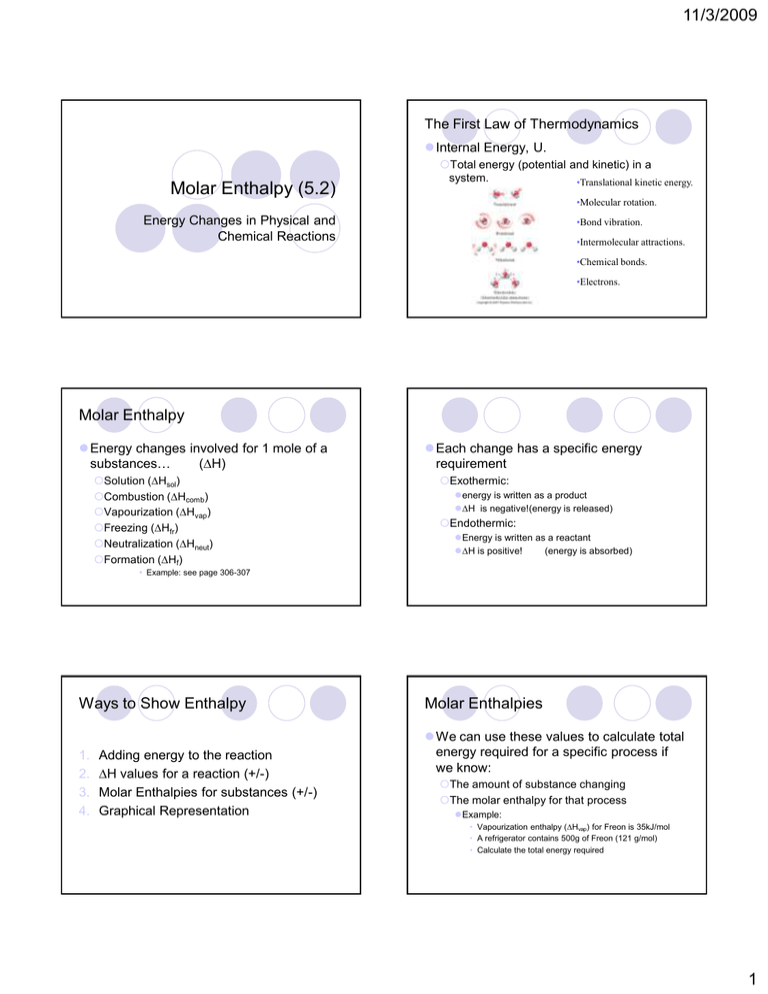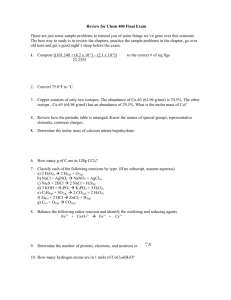Molar Enthalpy (5.2) 11/3/2009 The First Law of Thermodynamics Internal Energy, U.
advertisement

11/3/2009 The First Law of Thermodynamics Internal Energy, U. Molar Enthalpy (5.2) Total energy (potential and kinetic) in a system. •Translational kinetic energy. •Molecular rotation. Energy Changes in Physical and Chemical Reactions •Bond vibration. •Intermolecular attractions. •Chemical bonds. •Electrons. Molar Enthalpy Energy changes involved for 1 mole of a substances… (∆H) Solution (∆Hsol) Combustion (∆Hcomb) Vapourization (∆Hvap) Freezing (∆Hfr) Neutralization (∆Hneut) Formation (∆Hf) Each change has a specific energy requirement Exothermic: energy is written as a product ∆H is negative!(energy is released) Endothermic: Energy is written as a reactant ∆H is positive! (energy is absorbed) Example: see page 306-307 Ways to Show Enthalpy 1. 2. 3. 4. Adding energy to the reaction ∆H values for a reaction (+/-) Molar Enthalpies for substances (+/-) Graphical Representation Molar Enthalpies We can use these values to calculate total energy required for a specific process if we know: The amount of substance changing The molar enthalpy for that process Example: • Vapourization enthalpy (∆Hvap) for Freon is 35kJ/mol • A refrigerator contains 500g of Freon (121 g/mol) • Calculate the total energy required 1 11/3/2009 Thermochemical Equations • The stoichiometric coefficients always refer to the number of moles of a substance H2O (s) H2O (l) Thermochemical Equations • The physical states of all reactants and products must be specified in thermochemical equations. H = 6.01 kJ • If you reverse a reaction, the sign of H changes H = -6.01 kJ H2O (l) H2O (s) H2O (s) H2O (l) H = 6.01 kJ H2O (l) H2O (g) H = 44.0 kJ • If you multiply both sides of the equation by a factor n, then H must change by the same factor 2H2O (s) 2H2O (l) H = 2 x 6.01 = 12.0 kJ Combined Calculations Heating Curve for Water We can combine our equations for q and ∆H! Recall q = m c ∆T ∆H total = n ∆H(for the process) Therefore: n ∆H(for the process)= m c ∆T Phase Change Calculation Eg. What quantity of energy is liberated as 14.3g of water condenses at its boiling point? H = nH = 14.3 g x 1 mol x -40.65kJ 18.02g 1 mol = -32.3 kJ So, 32.3 kJ of energy are released as 14.3g condenses Energy Calculations solid: q = mc T, c = 2.00 J/g•°C s to l: H = nH, H = 6.01 kJ/mol liquid: q = mc T, c = 4.19 J/g•°C l to g: gas: H = nH, H = 40.65 kJ/mol q = mc T, c = 2.02 J/g•°C 2 11/3/2009 Combined Problems If a sample undergoes phase changes as well as temperature changes, the energy involved in each step must be calculated separately and then added together, taking care that common units are used. (Generally, molar enthalpies are expressed in units of kJ/mol, whereas specific heat capacities are expressed as J/g•°C) The most complicated question of this type would involve two phase change calculations and three changes in heat. What is the energy change for a 22.4g sample of water that is cooled from 35°C to -12°C under standard conditions? At 35°C, water is a liquid. As energy is removed, it cools to 0°C. At 0°C, it freezes. As more energy is removed, the solid water cools further. We must calculated the energy change for two different phases as well as one phase change. Cooling liquid: q = mc T = (22.4g)(4.19J/g•°C)(-35°C) = -3285 J = -3.285 kJ Freezing: H = nH = (22.4g / 18.02g/mol)(-6.01kJ/mol) = -7.47 kJ Cooling Ice: q = mc T = (22.4g)(2.00J/g•°C)(-12°C) = -538 J = -0.538 kJ Etotal = 11.3 kJ 3






